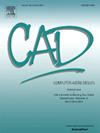Two-stage physics-informed deep neural networks framework for form-finding of tensegrity structures
IF 3.1
3区 计算机科学
Q2 COMPUTER SCIENCE, SOFTWARE ENGINEERING
引用次数: 0
Abstract
This paper proposes a two-stage optimization deep neural network method for form-finding of tensegrity structures, based on physical information. The total loss function of the neural network is constructed by comprehensively considering the physical information, including nodal residual forces, element length constraints, and minimum node distance. To enhance the learning ability of the neural network, a two-stage optimization model is adopted. In the first stage, the AdamW optimizer is employed for preliminary training of the network's hyperparameters, quickly reducing the loss values. Following the preliminary training, the l-BFGS optimizer is utilized in the second stage to refine the optimization and converge toward the optimal solution, resulting in the nodal coordinates that satisfy the structural equilibrium. The paper includes case studies on five different tensegrity models. The results show that the proposed two-stage physics-informed deep neural network (PIDNN) approach, utilizing dual optimizers, can efficiently and accurately perform form-finding for various tensegrity structures, including both single- and multi-stable models. The method provides reliable results, avoids complex finite element computations, and offers high computational efficiency.
张拉整体结构寻形的两阶段物理信息深度神经网络框架
提出了一种基于物理信息的张拉整体结构寻形的两阶段优化深度神经网络方法。综合考虑节点剩余力、单元长度约束、最小节点距离等物理信息,构建神经网络的总损失函数。为了提高神经网络的学习能力,采用了两阶段优化模型。在第一阶段,使用AdamW优化器对网络的超参数进行初步训练,快速降低损失值。在初步训练之后,第二阶段利用l-BFGS优化器对优化进行细化,并向最优解收敛,得到满足结构平衡的节点坐标。本文包括五种不同的张拉整体模型的案例研究。结果表明,利用双优化器的两阶段物理信息深度神经网络(PIDNN)方法可以高效准确地对各种张拉整体结构进行寻形,包括单稳定模型和多稳定模型。该方法计算结果可靠,避免了复杂的有限元计算,计算效率高。
本文章由计算机程序翻译,如有差异,请以英文原文为准。
求助全文
约1分钟内获得全文
求助全文
来源期刊

Computer-Aided Design
工程技术-计算机:软件工程
CiteScore
5.50
自引率
4.70%
发文量
117
审稿时长
4.2 months
期刊介绍:
Computer-Aided Design is a leading international journal that provides academia and industry with key papers on research and developments in the application of computers to design.
Computer-Aided Design invites papers reporting new research, as well as novel or particularly significant applications, within a wide range of topics, spanning all stages of design process from concept creation to manufacture and beyond.
 求助内容:
求助内容: 应助结果提醒方式:
应助结果提醒方式:


